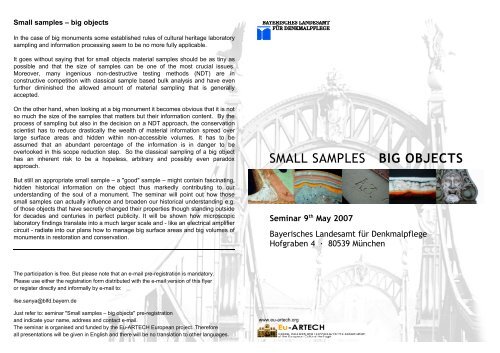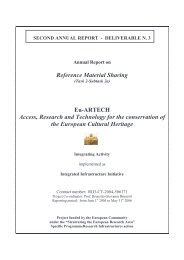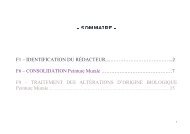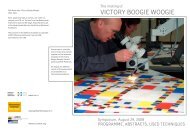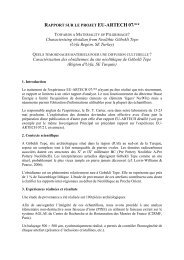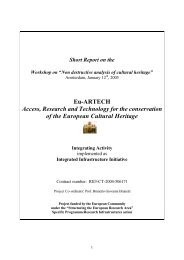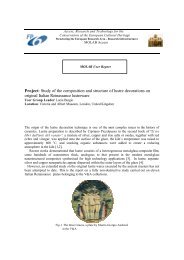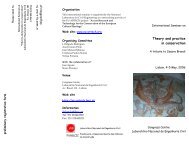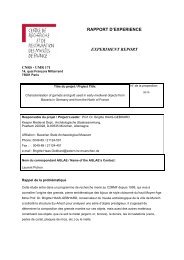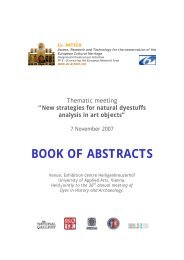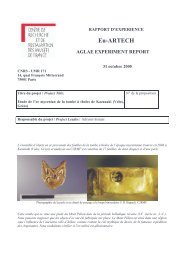Small samples big objects, Munich, May 9, 2007. - Eu-ARTECH
Small samples big objects, Munich, May 9, 2007. - Eu-ARTECH
Small samples big objects, Munich, May 9, 2007. - Eu-ARTECH
Create successful ePaper yourself
Turn your PDF publications into a flip-book with our unique Google optimized e-Paper software.
<strong>Small</strong> <strong>samples</strong> – <strong>big</strong> <strong>objects</strong><br />
In the case of <strong>big</strong> monuments some established rules of cultural heritage laboratory<br />
sampling and information processing seem to be no more fully applicable.<br />
It goes without saying that for small <strong>objects</strong> material <strong>samples</strong> should be as tiny as<br />
possible and that the size of <strong>samples</strong> can be one of the most crucial issues.<br />
Moreover, many ingenious non-destructive testing methods (NDT) are in<br />
constructive competition with classical sample based bulk analysis and have even<br />
further diminished the allowed amount of material sampling that is generally<br />
accepted.<br />
On the other hand, when looking at a <strong>big</strong> monument it becomes obvious that it is not<br />
so much the size of the <strong>samples</strong> that matters but their information content. By the<br />
process of sampling but also in the decision on a NDT approach, the conservation<br />
scientist has to reduce drastically the wealth of material information spread over<br />
large surface areas and hidden within non-accessible volumes. It has to be<br />
assumed that an abundant percentage of the information is in danger to be<br />
overlooked in this scope reduction step. So the classical sampling of a <strong>big</strong> object<br />
has an inherent risk to be a hopeless, arbitrary and possibly even paradox<br />
approach.<br />
But still an appropriate small sample – a "good" sample – might contain fascinating,<br />
hidden historical information on the object thus markedly contributing to our<br />
understanding of the soul of a monument. The seminar will point out how those<br />
small <strong>samples</strong> can actually influence and broaden our historical understanding e.g.<br />
of those <strong>objects</strong> that have secretly changed their properties though standing outside<br />
for decades and centuries in perfect publicity. It will be shown how microscopic<br />
laboratory findings translate into a much larger scale and - like an electrical amplifier<br />
circuit - radiate into our plans how to manage <strong>big</strong> surface areas and <strong>big</strong> volumes of<br />
monuments in restoration and conservation.<br />
The participation is free. But please note that an e-mail pre-registration is mandatory.<br />
Please use either the registration form distributed with the e-mail version of this flyer<br />
or register directly and informally by e-mail to:<br />
ilse.sanya@blfd.bayern.de<br />
Just refer to: seminar "<strong>Small</strong> <strong>samples</strong> – <strong>big</strong> <strong>objects</strong>" pre-registration<br />
and indicate your name, address and contact e-mail.<br />
The seminar is organised and funded by the <strong>Eu</strong>-<strong>ARTECH</strong> <strong>Eu</strong>ropean project. Therefore<br />
all presentations will be given in English and there will be no translation to other languages.<br />
SMALL SAMPLES BIG OBJECTS<br />
Seminar 9 th <strong>May</strong> 2007<br />
Bayerisches Landesamt für Denkmalpflege<br />
Hofgraben 4 · 80539 München<br />
www.eu-artech.org
Programme<br />
9:00 - 9:15 Arrival and registration<br />
9:15 - 9:25 Welcome address by Bayerisches Landesamt für Denkmalpflege<br />
Egon Johannes Greipl, head of BLfD<br />
9:25 - 9:45 The <strong>Eu</strong>-<strong>ARTECH</strong> project<br />
Bruno G. Brunetti, coordinator of the <strong>Eu</strong>-<strong>ARTECH</strong> project<br />
Universita' di Perugia, Perugia, Italia<br />
9:45 - 10:30 Sampling of a stone portal with microdrilling – decay profiles<br />
and past treatments<br />
José Delgado Rodrigues and Ana Ferreira Pinto<br />
Laboratório Nacional de Engenharia Civil, Lisboa, Portugal<br />
10:30 - 11:15 Nazca: a tiny tool for a large line<br />
Jörg Faßbinder<br />
Bayerisches Landesamt für Denkmalpflege, München, Deutschland<br />
11:15 - 11:30 Coffee break<br />
11:30 - 12:15 Fuzzy logic and neolithic wood<br />
Daria Yu. Hookk et al.<br />
Государственный Эрмитаж (The State Hermitage Museum), Санкт-Петербург, Россия<br />
12:15 - 13:00 Forever lost and found again? The conservator’s part in search<br />
of the original appearance of painted monumental metal <strong>objects</strong><br />
Elisabeth Krebs<br />
Freiberufliche Restauratorin, Wien, Österreich<br />
13:00 - 14:30 Lunch break<br />
14:30 - 15:15 From the monument to the microsample: a difficult problem of scale<br />
in the understanding of conservation problems<br />
Isabelle Pallot-Frossard<br />
Laboratoire de Recherche des Monuments Historiques, Champs-sur-Marne, France<br />
15:15 - 16:00 <strong>Small</strong> <strong>samples</strong> from giant buddhas<br />
Michael Petzet and Edmund Melzl<br />
International Council on Monuments and Sites (ICOMOS)<br />
16:00 - 16:15 Coffee break<br />
16:15 - 17:00 Sampling of biodeteriogens in monumental and archaeological<br />
areas – methods and usefulness<br />
Daniela Pinna<br />
Opificio delle Pietre Dure, Firenze, Italia<br />
17:00 - 17:45 Experiences with large collections and monuments – how to approach<br />
the analytical challenges<br />
Stefan Simon and Rupert Utz<br />
Rathgen-Forschungslabor, Berlin, Deutschland / ProDenkmal, Bamberg, Deutschland


